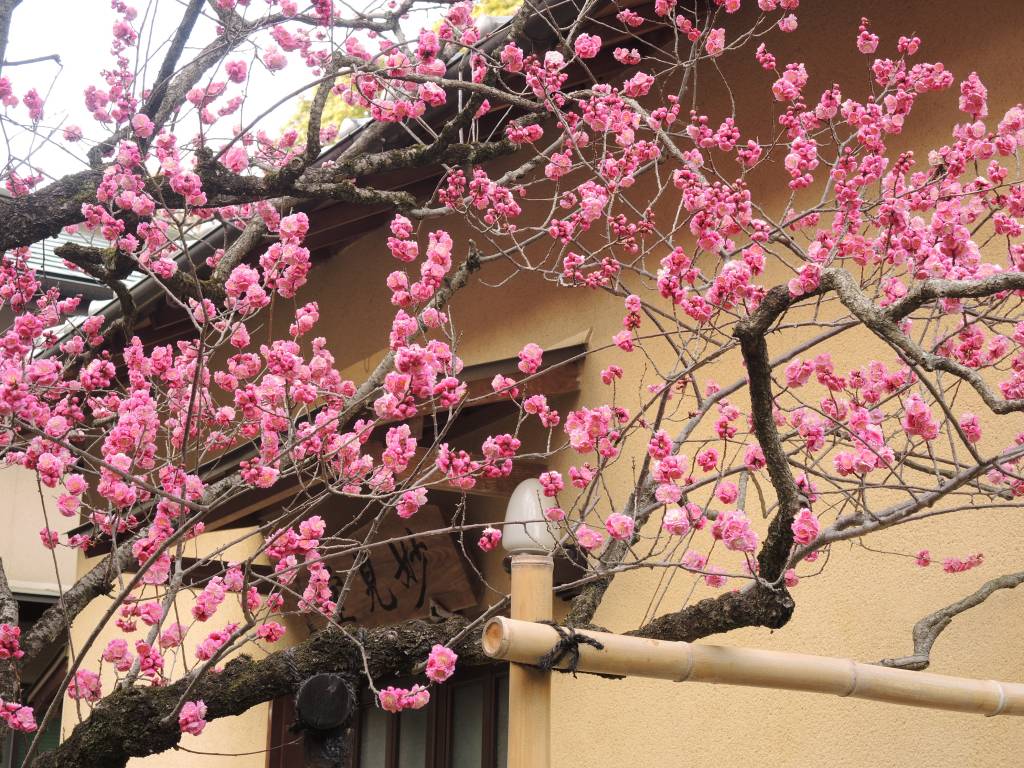合掌
日蓮聖人御入滅750年の報恩事業の一環として、
絵画の作成に取り組んでおります。
仏さまの教えを伝える絵のほか、
六老僧をはじめとする重要人物の肖像画の作成など、
様々な作品を準備しております。
常不軽菩薩(じょうふきょうぼさつ)という方のことは、
至るところで紹介されています。
ですから改めて説明することはないのですが、
要点をまとめると、
出会うすべての方を深く敬い、成仏を信じ、拝んだ修行者であり、
お釈迦さまの過去世の一つです。
本作は、その常不軽菩薩を描いた作品で、
作者は上村恭子(うえむら やすこ)さまです。
とても尊く神々しいですね。
お釈迦様の過去世なのだから当たり前なのかもしれません。
しかしこの方が過ごした日々は、
その徳の高さにはとても釣り合わない苦難の連続でした。
前述の通り、この方は出会うすべての人を敬い、仏になると約束し、手を合わせました。
すると、どうなったか。
皆様から感謝されたのでしょうか?
お互いに励ましあう、やさしく温かい世界が広がったのでしょうか。
いいえ。
常不軽菩薩は、
罵られました。
石を投げられました。
杖や刀で傷つけられました。
本作に描かれる痛々しい生傷や包帯、ボロボロになった衣は、
ありがたいはずの仏の使いに与えられた返礼なのです。
常不軽菩薩は、凶暴や残忍という概念とは対極の位置にいますが、
それでも畏怖すべき存在であることに違いはありません。
行動が極めて単純なのに、謎に満ちているからです。
なぜここまでがんばれるのか。
なぜ酷い迫害をされても人や運命を呪わないのか。
そして何より、なぜ「私」が仏になれると確信するのか。
この方が、これらの疑問に答えることはありません。
出会うすべての人を、ただただ拝むのみです。
これほどの方が、なぜ人に馬鹿にされ、いじめられているのか。
この疑問は、心が綺麗で立派な行いをする方は、
尊敬されるのが当然という考えが前提になっています。
だから、よく思われない人は立派ではなく、
道を踏み外しているという理屈が成り立ってきます。
しかし、他の聖人と比べてこの方が異質なのは、
そういう思い込みそのものを壊しに来ることにあります。
常不軽菩薩は間違いなく聖人ですが、
この方が人々に愛されたという描写は見られません。
ようやく敬われるようになるのは、
一度臨終を迎えそうになり、仏さまの教えを聞き、功徳が表面化した後です。
つまり、尊敬を勝ち取ったのは見た目でした。
ひたすら拝むという清らかな振る舞いの最中には人々から評価されず、
行いの尊さが明らかに身を飾るようになって初めて、この方は人々に信じてもらえたのです。
このことを踏まえると、ある疑念が湧いてきます。
私たちは、
人の心の高潔さや行いの尊さを判断できるのでしょうか。
自分の考え方とよく似ていながらも追いつけない深みに達した人や、
かつて夢見た生き方を実践する人を尊敬し、
立派だと思っているのではないでしょうか。
しかしそれは、今の自分の視野の範囲で遥か先を歩く存在に憧れているに過ぎず、
そもそも方向が正しいのかどうかは見落とされているのかもしれません。
そのことに気づけていないときに、
折悪く常不軽菩薩に目の前を横切られると、
自分の中の何かが狂ってしまい、
怒り、罵り、酷いときには暴力に走ってしまうのではないでしょうか。
常不軽菩薩を見たときに、
無心に手を合わすか、思いつく限りの悪態をつくかが、
人生の分かれ目になります。
いわば究極の選択です。
究極の選択と言えば、
連帯保証人の友人にすべてを擦り付けて逃げるか、
それとも誇りを捨てずに自分で処理するかという、
わかりやすい危機を想像します。
しかし、
遠い未来に振り返ったときにようやく思い至るような、
当時は注意を向ける価値さえ感じられなかった何気ない選択もまた、
人生の大きな分岐点になってしまうことがあります。
それがいつ来るのかはわかりませんし、
実は今さっき無意識に選び、覚えてさえいないことがそれだったのかもしれません。
そのとき本当に目を開けていられたのかが心配になります。
本作の常不軽菩薩は、片方の目から涙を流しています。
この方は、我々が仏になるともちろん知っています。
しかし頭のもう半分では、
いまだに苦しみ続ける私たちに対して、
何か違うことを思っておられたはずです。
少なくともそれは、怒りや恨みではありません。
The one called Sadāparibhūta(Jou-Fukyo-Bosatsu)
has been featured everywhere.
So I won't explain it again.
To summarize:
He was a practitioner who deeply respected everyone he met, believed, and worshiped enlightenment,
which was one of Buddha's past lives.
This work is a work depicting the Sadāparibhūta.
The author is Yasuko Uemura.
The work is so grand and divine.
It may be natural because it is the past life of Buddha.
But the days he spent
was a series of hardships that were out of proportion to his high virtue.
As mentioned above, he respected everyone he met, promised to become Buddha, and put his hands together.
What happened after that?
Did everyone thank him?
Did a gentle and kind-hearted world that encourages each other spread?
No.
Sadāparibhūta
was reviled.
People threw stones at him.
People hurt him with sticks and swords.
The painful raw wounds, bandages, and ragged clothing depicted in this work are
reciprocation given to the messenger of the Buddha whom people should be grateful.
Although Sadāparibhūta is the opposite of the concept of ferocity and cruelty,
he is still someone people should honor and fear.
This is because he is full of mysteries although the actions are extremely simple.
Why can he try so hard?
Why didn't he curse people and fate even when he was severely persecuted?
Above all, why did he have the conviction “I” can become a Buddha?
He didn’t answer these questions.
He just worshiped everyone he met.
Why are so many people mocked and bullied?
This question is for those who have a pure heart and do good deeds.
It is based on the idea that it is natural to be respected.
Therefore, people who are not well regarded are not respectable.
It makes sense that you're way off track.
However, Sadāparibhūta is different from other saints,
because he destroys these beliefs.
Although Sadāparibhūta is undoubtedly a saint,
there is no description that he was loved by people.
He was finally respected after
he was about to die, and people heard the teachings of Buddha, which resulted in his merits coming to the surface.
In other words, the appearance won the respect of the people.
He wasn’t respected by people when he had a pure demeanor of earnestly worshiping.
It was only when the dignity of his deeds became evident that people believed in him.
You may have some doubts when you think about these things.
Are we
able to judge the integrity of a person's heart and the dignity of his or her deeds?
Do you respect people, who are very similar to your own way of thinking but have reached
a depth that you can't catch up with, or hold people in high esteem,
who practice the way of life you once dreamed of?
However, that is nothing more than longing for an existence that walks far ahead within the scope of your current field of vision.
You may be overlooking whether the direction is correct in the first place.
When you are unable to realize that,
when the Sadāparibhūta passes by you,
something inside you goes crazy,
and may lead you to be angry, curse people, and even be violent in extreme cases.
When you look at Sadāparibhūta,
will you put your hands together innocently or curse as much as you can think of?
This will be the turning point in your life.
It is, so to speak, the ultimate choice.
When you think about the ultimate choice,
you may imagine a simple crisis, such as handing over everything on your friend,
who is a co-signer and run away,
or handle it yourself without throwing away your pride.
However,
a casual choice that didn't even feel worth paying attention to at the time,
may be a big turning point in your life,
which you may finally realize when you reflect in the distant future.
You don't know when that time will come.
In fact, it may have been that you unconsciously chose it just now and don’t even remember it.
It makes you anxious whether you were really able to keep your eyes open.
The Sadāparibhūta in this work is crying from one eye.
Of course, he knows that we will become a Buddha.
However, he must have also thought
of something else for those
of us who continue to suffer.
At least it's not anger or resentment.
檀信徒の方はこちらもご覧ください。
よくある質問をまとめております。
ご相談の際は、お寺にお越しになる前にご予約をお願いします。


